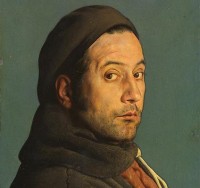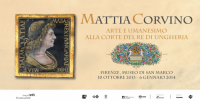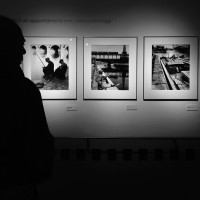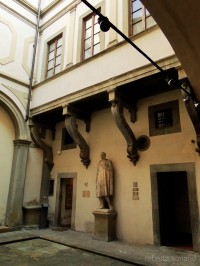By Maria Rosa Ventimiglia (University of Florence)
The exhibition is dedicated to Pietro Annigoni, however, we are surrounded by the work of Giovanni Michelucci who reconstructed the interior concept of the formerly known Palazzo Pucci, now host to the historic setting of Cassa di Risparmio di Firenze. Open to the public free of charge from 16 October 2013-6 January 2014, the exhibit aims to commemorate the presence of the great artist [Pietro Annigoni] from Milan in Florence in the twenty-five years of his death.
Emanuele Barletti, Arabella Cifani and Franco Monetti curate the exhibition. The exhibit was born from the collaboration between the Foundation Cassa di Risparmio di Firenze and the Foundation Guelpa of the city of Ivrea. This city, Ivrea, is where Abdone Croff was born, this man was a friend and patron of Pietro Annigoni. Croff collected many works by Annigoni during the years of their friendship. This collection merged within the Foundation Guelpa after following the wishes of Abdone Croff’s sister-in-law, Lucia Guelpa.
This collaboration has resulted in the need to make more than 150 works public, first in Florence and then Ivrea. The works belong to the two Trustees but also to numerous private collectors who, thanks to their generosity, have made this exhibition possible when the works would have otherwise been unreleased.
The artist’s works are characterized by a highly expressive and lyrical vision. They are divided into three main groups, which are easily distinguishable not only by the internal architecture of the building, but also to the great explanatory panels. These text panels are placed at the beginning of each room and have black and pink detail about each section.
The first room, paved with marble and lined with slabs of stone, has the function of presenting the artist. It begins with his life, told by Annigoni himself during an interview for the channel RAI. It continues with his works, which are all collected in a monumental monograph with an original ligature crafted in fine wood and leather. They were then placed on a tall lectern, giving visitors the opportunity to get acquainted with the works that they will encounter later.
The criterion chosen for this room emphasizes the association between Abdone Croff and Pietro Annigoni, but also to compare different works of art belonging to the two foundations. It highlights the unique chronological and thematic similarities from which it gives rise to the idea of collaboration.
After passing the entrance, the second room focuses solely on the exposure of new works belonging to private collectors, some of which are being displayed to the public for the first time. These unreleased works, which are clearly indicated on the panels, should have been emphasized greater and differentiated by using a display device.
Among the many singularities, there is also an abstract painting that draws our attention: a mixed media composition made only with those backgrounds of black, red and blue. It is a work that attests to the Annigoni’s will to grapple with Abstract art.
The few works of art that are part of the permanent collection of the Cassa di Risparmio di Firenze, which are normally exposed, disturb the exposition path. The monumental landscape of Niccolò Cannicci is unsuccessfully hidden from imposing portrait of Baroness Stefania Von Kories.
The great versatility of Annigoni, through the use of various artistic techniques, is confirmed in the last room. The space was intended to accommodate the numerous portraits of the people closest to the artist: the mixed technique for portraits of children, Benedetto and Ricciarda, to the pencil portrait of his mother, Teresa. The works shown in this room allows the visitor to immerse themselves for a moment in the private life of Annigoni: from retracing his days on his bike or his evenings in the company of his daughter who, as evidenced by a photos of the time, he used to entertain his family by playing the harp.
It is a beautiful exhibit, however, the visitor must have knowledge on the artist in order to appreciate the visit. In fact, without having an audio guide at all and text panels in English, the exhibit fails to attract a wider audience from the every day public of Via Bufalini.
For more information visit the website: http://www.firenzepost.it/2013/10/20/pietro-annigoni-opere-inedite-in-mostra-a-firenze/
Pietro Annigoni: Presenza di un artista.
Incorniciata da una delle più note ristrutturazioni di interni concepita da Giovanni Michelucci, la sede storica della Cassa di Risparmio di Firenze (l’antico Palazzo Pucci), la mostra dedicata a Pietro Annigoni, aperta al pubblico gratuitamente dal 16 ottobre 2013 al 6 gennaio 2014, si propone di commemorare la presenza del grande artista milanese a Firenze nel venticinquennale della sua morte.
L’esposizione curata da Emanuele Barletti, Arabella Cifani e Franco Monetti, nasce dalla collaborazione tra la Fondazione Ente Cassa di Risparmio di Firenze e la Fondazione Guelpa della città di Ivrea. Tale città è infatti il luogo di nascita di Abdone Croff, amico e mecenate di Pietro Annigoni, il quale raccolse durante gli anni della loro amicizia, una grande quantità di opere dell’artista, poi confluite nella fondazione Guelpa per volere della cognata Lucia Guelpa. Questa collaborazione è quindi scaturita dalla volontà di rendere pubbliche, prima a Firenze e poi a Ivrea, più di 150 opere dell’artista appartenenti sia alle due fondazioni sia ai numerosi collezionisti privati che, grazie alla loro generosità, hanno reso possibile l’esposizione di opere inedite.
I lavori dell’artista, caratterizzati da una visione lirica ed estremamente espressiva, sono suddivisi in tre nuclei principali facilmente distinguibili grazie non soltanto alla struttura architettonica interna del palazzo ma soprattutto ai grandi pannelli esplicativi che, collocati all’inizio di ogni sala, presentano nero su rosa ogni dettaglio riguardante la sezione presentata.
La prima sala, pavimentata in marmo e rivestita da lastre di pietra serena, ha la funzione di presentare l’artista: la sua vita, raccontata da Annigoni stesso durante un’intervista per il canale Rai, e le sue opere, tutte raccolte in una monumentale monografia con un’originalissima legatura artigianale in legno pregiato e pelle che, posta su un alto leggio, dà l’opportunità al visitatore di familiarizzare con le opere che ritroverà successivamente durante il percorso.
Il criterio espositivo scelto per questa sala permette di porre l’accento sul sodalizio tra Abdone Croff e Pietro Annigoni ma anche di confrontare le diverse opere del nostro artista appartenenti alle due fondazioni, esaltando le corrispondenze cronologiche e tematiche tra le due differenti raccolte, motivo da cui è scaturita l’idea della collaborazione.
Superato l’atrio, la seconda sala si concentra unicamente sull’esposizione di opere appartenenti a collezionisti privati alcune delle quali, come si è già detto, sono mostrate al pubblico per la prima volta. A queste opere inedite, anche se chiaramente indicate nel pannello esplicativo, si sarebbe dovuto dare un maggior risalto rispetto a quelle già esposte in precedenti occasioni, differenziandole con qualche accorgimento nell’allestimento. Tra le tante singolarità, anche un dipinto astratto attira la nostra attenzione: una composizione a tecnica mista realizzata solo con campiture di coloro nero, rosso e celeste, un’opera che attesta la volontà del Maestro di cimentarsi con l’astrattismo.
Le poche opere facenti parte della collezione permanente della Cassa di Risparmio di Firenze, lì normalmente esposte, contribuiscono a disturbare visivamente il percorso espositivo, come il monumentale paesaggio di Niccolò Cannicci, mortificato e nascosto senza successo dal ritratto imponente della Baronessa Stefania Von Kories.
La grande poliedricità di Annigoni nell’utilizzo delle diverse tecniche artistiche viene ribadita nell’ultima sala, il cui spazio è destinato ad accogliere i numerosi ritratti delle persone più vicine all’artista: dalla tecnica mista per i ritratti dei figli Benedetto e Ricciarda, al ritratto in lapis della madre Teresa. Le opere esposte nella sala dove sono raggruppate le testimonianze familiari, permettono al visitatore di immergersi per un attimo nella vita privata del Maestro, ripercorrendo le sue giornate trascorse anche andando in bicicletta o le sue serate in compagnia della figlia che, come dimostra una testimonianza fotografica, usava intrattenere i suoi familiari suonando l’arpa.
Esaustiva in tutte le sue sfaccettature, la mostra arricchisce le informazioni in possesso di un visitatore già esperto. Infatti, priva di cartelli in lingua inglese e di audio guide, non riesce ad attirare un pubblico più ampio che pure ogni giorno affolla via Bufalini.
Per maggiori informazioni visitare il sito: http://www.firenzepost.it/2013/10/20/pietro-annigoni-opere-inedite-in-mostra-a-firenze/



